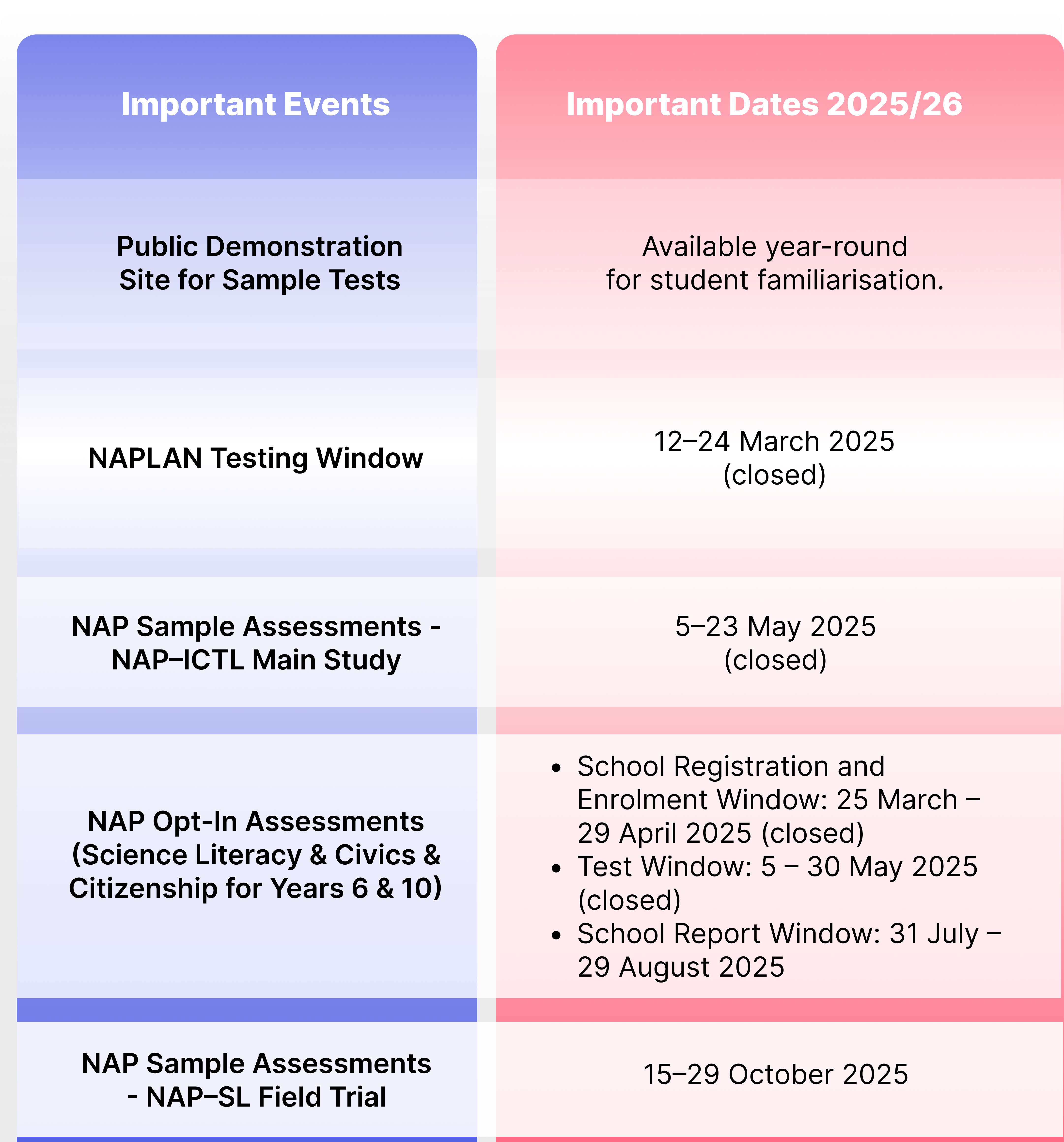NAPLAN (National Assessment Program – Literacy and Numeracy) has been an important part of Australian education since 2008, assessing students' literacy and numeracy skills. It helps identify areas of strength and where additional support might be needed.
Over the past few years, several changes have been made to the exam. Parents and teachers of children aged 3-12 may be wondering: What are the key changes to expect? How will these changes impact my child's experience? And, most importantly, how can we best prepare?
This blog will answer these questions directly, outlining the NAPLAN 2025 changes and providing practical tips to help you adapt to these changes. By the end, you'll have a clear understanding of what's new and how to help your child succeed.
TL;DR
-
NAPLAN 2025 Testing Window was scheduled from 12th to 24th March, with schools having nine days to complete assessments.
-
NAPLAN is now conducted digitally (except for Year 3 writing), with new proficiency levels: Exceeding, Strong, Developing, and Needs Additional Support.
-
Familiarize your child with online practice tests, focus on targeted practice for weak areas, and help them manage time constructively during the test.
-
Keep track of important dates and stay in touch with your child's school for specific schedules.
-
Create a calm, balanced study routine with regular breaks, focusing on building confidence, not just test performance.
What is NAPLAN: Overview and Purpose

NAPLAN stands for the National Assessment Program, Literacy and Numeracy. It's an annual assessment conducted in Australia for students in Years 3, 5, 7, and 9. The test evaluates core skills in reading, writing, spelling, grammar, punctuation, and numeracy, providing a snapshot of a student's abilities in these fundamental areas.
The primary purpose of NAPLAN is:
-
Monitor Student Progress: NAPLAN helps track how well students are developing essential literacy and numeracy skills over time.
-
Inform Teaching and Learning: The results assist teachers in identifying areas where students may need additional support or enrichment.
-
Guide Educational Policy: NAPLAN data provides insights for policymakers to allocate resources constructively and implement strategies to improve educational outcomes.
-
Empower Parents: It offers parents a clearer understanding of their child's academic progress compared to national standards.
While NAPLAN is not a pass-or-fail test, it serves as a valuable tool for assessing and supporting your child's educational journey.
Now that we have a clear understanding of what NAPLAN is and its purpose, let's explore the recent changes in the exam.
Key NAPLAN 2025 Dates: Plan Ahead

The 2025 schedule brings some shifts. For example, the NAPLAN test was moved to March. The test window for 2025 was set from 12th to 24th March. Schools have a nine-day window during this period to complete assessments for all participating year groups.
Here are the key NAPLAN 2025 dates to keep in mind:

With the key date shifts in mind, let's take a look at how the exam features have transformed.
Also Read: Is NAPLAN Compulsory for Students?
What's New for NAPLAN 2025: Changes and Impact

NAPLAN 2025 participation rates have hit 93.8% across all year levels and tests, marking the highest participation since 2017. It is a promising sign that the changes to NAPLAN are making the assessment process more inclusive and accessible.
Other than this, here are a few new expectations and NAPLAN 2025 changes:
1. Earlier Test Window
The NAPLAN test is now conducted in March, a shift from its traditional May timing. This earlier window allows for quicker turnaround of results. It enables timely interventions and support where needed.
2. Updated Proficiency Levels
In practice, NAPLAN results are reported against four proficiency levels:
-
Exceeding
-
Strong
-
Developing
-
Needs Additional Support
This change replaces the previous 10 proficiency bands, providing a clearer picture of student progress and areas needing attention.
3. Digital Testing with a Paper Exception
Most students in Years 5, 7, and 9 complete NAPLAN online, except the Year 3 writing test, which remains paper-based. The online format offers a more adaptive testing experience, tailoring questions to each student's performance level.
4. Faster Results
The digital format facilitates quicker processing, meaning results are expected to be available sooner. This allows teachers and parents to identify strengths and areas for improvement promptly.
5. NAP Sample Assessments
Schools can opt into additional assessments in science literacy, civics, and citizenship for Years 6 and 10. The test window for these assessments was from 5th to 30th May, with school registration running from 25th March to 29th April.
Understanding these changes helps in preparing students constructively and making sure they feel confident and supported throughout the NAPLAN process.
Also Read: Understanding NAPLAN's Adaptive Testing Online
Now, with all these changes surrounding us, let's see as parents or teachers how we can help our children prepare constructively.
Adapting to NAPLAN 2025 Changes: Tips for Smooth Transition

NAPLAN 2025 changes to the test format and reporting mean that preparation needs to be more targeted than ever. With over 1.3 million students taking NAPLAN tests this year, the goal is to help students approach the test with confidence, not overwhelm.
Here's how to help your child adapt to the 2025 changes effectively.
1. Get Comfortable with the Digital Format
NAPLAN 2025 is mainly digital, which means your child needs to be comfortable using technology for their tests. With early preparation, students can adapt to the online testing environment and perform with ease.
-
Actionable Tip: Make use of the practice tests available online. Set up a quiet, distraction-free environment at home for your child to practice on a computer or tablet.
2. Focus on Strengths and Areas for Growth
The new four proficiency levels (Exceeding, Strong, Developing, Needs Additional Support) offer a clearer picture of where students stand. If your child has struggled with specific areas in previous years, focus on those while maintaining a steady routine for topics they excel in.
-
Actionable Tip: For example, if writing is a challenge, focus on practice writing sessions. Use feedback from teachers to help guide your child's practice schedule. Strengthening these key areas will boost their confidence.
3. Use Practice Tests to Pinpoint Weaknesses
While practice tests are available, it's essential to use them with intention. The goal is to use the results to identify areas where your child might need extra support.
-
Actionable Tip: After each practice test, review the questions your child found difficult. Focus on those topics in your next study session.
4. Teach Time Management for the Digital Test
With the digital test format, it's easy to lose track of time, especially if your child gets stuck on a difficult question. Teaching time management will ensure they pace themselves and don't rush through the easier questions.
-
Actionable Tip: During practice, set a timer for each section. Encourage your child to move on from difficult questions and come back to them later if time permits.
5. Stay Flexible and Informed
Given the changes, staying informed and flexible with your preparation strategy is crucial. With the earlier test window and adjustments to the test itself, you'll need to keep up to date on scheduling and any further changes.
-
Actionable Tip: Keep an eye on official NAPLAN updates and your child's school communications for any changes or announcements. This proactive approach will ensure you can adjust your study plans in time and help your child stay organized.
Adapting to the NAPLAN 2025 changes doesn't need to be overwhelming. With the right preparation strategy, these changes can be a positive step in your child's academic journey.
CTA: Not sure how to bring this adaptiveness into your routine? Try the FunFox way! Book a free trial class to see it in action.
Also Read: Understanding NAPLAN Scores for Year 7 Students
Conclusion
NAPLAN 2025 brings changes that can be successfully implemented with the right approach. By focusing on understanding the test format, targeting areas for improvement, and managing test-day stress, you'll help your child build the confidence they need. Remember, the goal is not just to perform on the test, but to help your child develop the skills that will last well beyond it.
If you're looking for extra support to strengthen your child's skills, FunFox offers customized online tutoring programs. Our interactive, small-group sessions are designed to make learning fun while reinforcing essential literacy and numeracy concepts. Funfox's Writers Club and Readers Club are designed to build foundational skills in a fun and supportive environment.
Ready to uplift your child's skills? Register for a free trial class today and start the learning journey with FunFox!
FAQs
1. How will the digital format impact my child's test experience?
The digital format makes NAPLAN more interactive, adjusting the difficulty based on your child's answers. It's essential to help them practice with online tools beforehand so they feel confident figuring out the test on a computer or tablet.
2. Can I request special accommodations for my child during NAPLAN?
Yes, if your child has specific learning needs, accommodations like extra time or assistive technology can be requested through the school. Schools will work with parents to make sure that students are supported appropriately.
3. What happens if my child misses the test during the NAPLAN window?
If your child misses any part of NAPLAN, there will be a make-up testing window. This year's window was from 18–20 May 2025. Be sure to check with the school for the exact dates and arrangements for missed assessments.
4. Will the changes in reporting proficiency levels affect how we understand my child's performance?
Yes, the new four proficiency levels (Exceeding, Strong, Developing, Needs Additional Support) will provide clearer insights into your child's strengths and areas needing improvement, making it easier to focus on targeted support.
5. How can I help my child prepare without overwhelming them?
Focus on building their confidence through regular, short practice sessions, rather than cramming. A calm approach with plenty of breaks will help them stay engaged and ready for test day.














